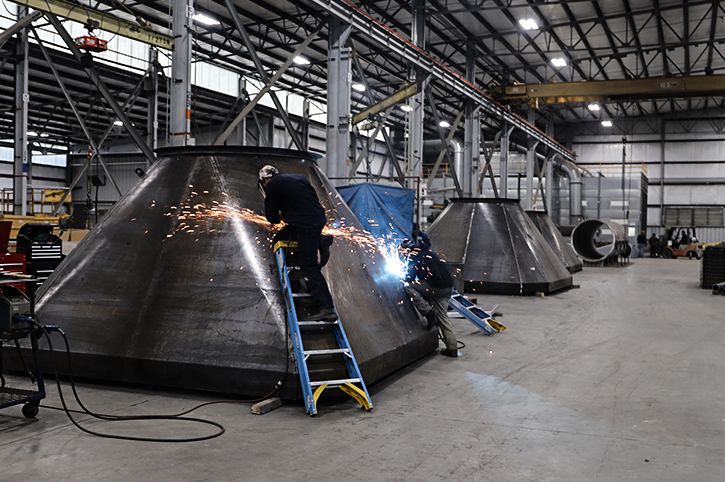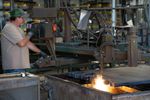Behind every successful metal fabrication is a safety-first workplace policy that includes welding safety best practices to protect employees on the shop floor. Healthy, safe workers are more productive and make fewer mistakes, which in turn increases quality control.
Safeguarding welding tasks is a challenge for any fabrication operation, due to potentially hazardous spatter and weld smoke released into the indoor work environment. Welding stainless steel, nonferrous chromium alloys, or similar “hot work” can release hexavalent chromium and other toxins that can easily be inhaled through the nose or mouth, and can target the respiratory system.
Without safety protocols, welders are at risk for:
- Spatter or spark burns on exposed, unprotected skin
- Cutting mishaps due to limited visibility from weld smoke
- Rashes or skin ulcers from hexavalent chromium exposure
- Nosebleeds, sores, or even perforations in the nasal septum
- Asthma or lung cancer from long-term weld smoke exposure
Worse yet, combustible gases can build up in feed welds, where just a single spark can ignite an explosion and endanger the entire shop floor. Training is key to mitigating these welding hazards, with an ounce of prevention worth millions in peace of mind.
Implement Safety-First Welding Practices
Welding safety begins with a quality control program that focuses on education, especially when it comes to material handling and equipment operation. A reputable metal fabricator will include safety training as part of their documented quality control program.
This safety training may include:
- Properly using PPE, such as 3M masks with welder hoods
- Protecting against falling objects (welder helmets obscure vision that prevents the worker from noticing a falling object)
- Checking welding aprons, gloves, or other protective clothing for tears or holes that can leave skin exposed
- Inspecting goggles and face shields for scratches that impair visibility
- Selecting proper welding equipment that should only be used after equipment protocol training is complete
This education is essential to preventing metal fabrication mistakes due to welding mishaps, such as hot spatter accidents.
Prevent Spatter Hazards
Generated at or near the welding arc, spatter is generated from working with metals of different thickness or from incorrect welding settings, such as setting the voltage or amperage too high.
Dangerously hot spatter can reach up to 35 feet from any welding area, placing employees at risk for eye injuries, burns, and spark-fire hazards.
Spatter safety begins with best practices such as:
- Wearing a welding hood and shield to protect eyes from potential sparks
- Using leather gloves to protect against spatter and hot welding surfaces
- Adding a leather apron or vest, if a complete welding suit is not available
- Posting specific diagrams and examples to follow near equipment that explain how to prevent spatter
- Providing proper metal cutting and forming education to prevent accidents and mishaps
Of course the best way to avoid spatter is to prevent it from occurring in the first place.
An established fabrication quality control program includes welding training to avoid errors that cause spatter, such as:
- Selecting poor-quality welding wire
- Using incorrect gas mixtures
- Welding on poor surface conditions (such as oily parts, rust, etc.)
- Applying improper torch angles or incorrect wire stick-out lengths
- Selecting a welding location without checking for grounding
Safety-driven metal fabricators also use OTC welding machines that ensure a constant power output to prevent spatter, unlike more traditional MIG machines with inconsistent power outputs.
Minimize Indoor Air Quality Risks
Welding dust and fumes can threaten employee safety, derail productivity, and place shop owners directly in the crosshairs of the EPA. These airborne contaminants can also reduce the life of cooling fans and valuable CNC machinery – eventually impacting fabrication quality.
Proper ventilation and fume-extraction tools can minimize these indoor air hazards, but additional PPE such as 3M masks and other precautions may be required to ensure a safe, productive welding environment.
Additional indoor air quality safety measures include:
- Understanding which metals produce the most dangerous toxic fumes, such as stainless steel, lead, copper, zinc, cadmium, or beryllium
- Posting safety data sheets and providing quality control manuals to flag potential health risks associated with specific types of metal
- Avoiding welding in confined areas, such as tanks, without proper ventilation equipment, such as fresh air hoods
Plus, employees should never weld surfaces contaminated with unknown material or use carbon dioxide shielding gas without proper ventilation and/or PPE.
Following these critical safety protocols during welding is key to controlling fabrication production costs and creating higher quality results.
Increase ROI With Safe Welding Practices
Full-service metal fabricators understand the ROI of protecting their most important long-term assets: their employees. Healthy employees are much less likely to make welding mistakes that can lead to financially disastrous results, such as:
- Poorly-fused welds that can lead to breaks and product failure
- Miniscule holes from inconsistent welds that leave the metal vulnerable to corrosive rust
- Welds that fail to meet OSHA industrial access regulations or industry-specific requirements
At Southern Metal Fabricators, we only employ certified, safety-conscious welders to prevent compromised fabrications that lead to compromised user safety. Our documented quality control program aligns with welding standards per AWS, ASTM, and CWB specifications and adheres to specific industry safety standards, such as material thickness, in each metal fabrication.
Additionally, we deliver metal fabrication ROI via:
- Documentation for every fabrication, including QC inspection paperwork for welding certification
- Visual support of QC documentation, such as detailed photographs
- Dedicated QC inspectors who ensure every metal fabrication meets or exceeds safety and quality standards
If you’re ready to work with a custom metal fabricator that goes beyond OSHA compliance to deliver true fabrication ROI, give us a chance to say, “Yes, we can do that!” by contacting us today.





